GLOBAL CLIMATE REPORT
1. Context
The world’s glaciers melted at dramatic speed last year, with global sea levels rising at double the pace they did two decades ago, a UN climate report said on Friday, ahead of Earth Day.
The report released on Friday shows that record levels of heat-trapping by greenhouse gases is causing large-scale changes to the land, ocean, and the atmosphere.
2. Key takeaways
The WMO State of the Global Climate report 2022 focuses on key climate indicators- greenhouse gases, temperatures, sea level rise, ocean heat and acidification, sea ice and glaciers
It also highlights the impacts of climate change and extreme weather:
1.Drought, floods and heatwaves affect large parts of the world and the costs are rising
2.Global mean temperatures for the past 8 years have been the highest on record
3.Sea level and ocean heat are at record levels – and this trend will continue for many centuries
4.Antarctic sea ice falls to lowest extent on record
5.Europe shatters records for glacier melt
- The report said the years between 2015-2022 were the warmest on record. The heatwave which struck Europe last summer caused more than 15,000 deaths
- The melting rate of some European glaciers was also “off the charts,” according to the report, with some glaciers losing up to 1.3 meters (4.3 feet) of average thickness between October 2021 and October 2022
- This is due to the high level of greenhouse gases which have already been emitted, causing water to continue to rise for “thousands of years.”
3. High Temperatures
- The La Nina cooling weather phenomenon failed to ease the temperature hikes, with the past eight years considered the highest mean temperatures on record
- In 2021, greenhouse gas concentrations peaked. Carbon dioxide (CO2) concentration was at 415.7 parts per million globally, which is 149 per cent of the pre-industrial level. Methane meanwhile stood at 262 per cent and nitrous oxide at 124 per cent. 2022 data suggested they continued to increase
- Oceans were meanwhile the warmest on record. Some 58 per cent of ocean surfaces experienced a marine heatwave
- Around 90 per cent of the energy trapped in the climate system by greenhouse gases goes into the ocean, somewhat ameliorating even higher temperature increases but posing risks to marine ecosystems
- The good news would be that we would be able to phase out this negative trend and even reach the 1.5 degrees (Celsius) limit
- We have the tools, the knowledge, and the solutions. But we must pick up the pace. We need accelerated climate action with deeper, faster emissions cuts to limit global temperature rise to 1.5 degrees Celsius
- We also need massively scaled-up investments in adaptation and resilience, particularly for the most vulnerable countries and communities who have done the least to cause the crisis
4. About Earth Day
- Every year, April 22 is celebrated as Earth Day, an annual event where people take time out to demonstrate their support for protecting the planet and its environment
- For 2023, the theme for Earth Day is “Invest in our planet,” calling for people and businesses to work together towards building a healthy economy for the planet
- According to EarthDay.org, which coordinates Earth Day events globally, the theme for the 2023 Earth Day calls on humanity to build a healthier economy while also making sure we work towards a more equitable future for everyone
- For this to happen, businesses, inventors, investors, and financial markets should lead the way by encouraging green innovation and practices. The private sector holds incredible power that can be wielded to bring about significant large-scale changes
- The first Earth day was celebrated more than 50 years ago on April 22, 1970
- In a 1969 UNESCO conference, peace activist John McConnell proposed a day to honour the Earth and the concept of peace.
- The organisation selected March 21 next year to celebrate this day, planning for it to coincide with the vernal equinox, which marked the first day of spring
- A large number of the team working with the senator and Hayes were college students, and April 22 in 1970 fell on a Wednesday, which was the middle of the week, meaning that most college students would be on campus
- The event was a wild success with more than 20 million Americans participating, according to some estimates
|
For Prelims: Global Climate Report, World Meteorological Organisation, Greenhouse Gas
For Mains: 1. Discuss the Socio-Economic impact of Climate Change in India. (250 Words)
|
|
Previous Year Questions:
1.“Momentum for Change: Climate Neutral Now” is an initiative launched by (UPSC 2018)
(a) The Intergovernmental Panel on Climate Change Answer (c)
2.Which one of the following is not related to the United Nations? (UPSC 2010)
(a) Multilateral Investment Guarantee Agency Answer (d)
|
Source: indianexpress
JUVENILE
1. Context
The National Commission for Protection of Children (NCPCR) has recently issued guidelines for conducting a preliminary assessment by the Juvenile Justice Board (JJB) under Section 15 of the Juvenile Justice Act, 2015 (JJ Act, 2015).
This preliminary assessment is to ascertain whether a juvenile can be tried as an adult.
Replacing the Jenuvile Justice Act, of 2000, the 2015 Act, for the first time, provided for trying juveniles in the age group of 16-18 as adults in cases of heinous offences.
2. About Juveniles
- Juveniles are the person who has not attained the age of majority which means those who are below 18 and have committed a crime whether it is heinous or not.
- They are also known as juvenile offenders or juvenile delinquents. For example, the minimum smoking age in India is 18 and people below that are called minors or underage.
- The Juvenile cases are heard in juvenile court, a type of civil court with different rules than an adult criminal court.
- However in certain cases, older juveniles can be tried as adults in criminal court.
3. How can Children get tried as an adult
- The Act has categorised the offences committed by children into three categories petty offences, serious offences and heinous offences.
- Section 15 of the JJ Act provides that in case of a heinous offence alleged to have been committed by a child, who has completed or is above the age of sixteen years, the Board shall conduct a preliminary assessment regarding his mental and physical capacity to commit such offence, ability to understand the consequences of the offence and the circumstances in which he allegedly committed the offence.
- Section 18 (3) of the Act further suggests that, if the Board, after preliminary assessment under section 15 passes an order that there is a need for a trial of the said child as an adult, then the Board may order the transfer of the case to the Children's court having jurisdiction to try such offences.
- Thus, the sole objective of having such a preliminary assessment is to determine whether a child within the age group of 16-18 years should be tried as an adult in case of heinous offences.
4. The responsibilities of the Board
- The guidelines further make it clear that the JJB shall be responsible for the preliminary assessment and provide the child, the child's family and their counsel with a copy of the order.
- It further states that in case the JJB does not have at least one member who is a practising professional with a degree in child psychology or child psychiatry, the Board shall take the assistance of psychologists or experts who have experience working with children in difficult times.
- The child should also be provided with legal aid counsel through the District Legal Service Authority and shall be present during the preliminary assessment.
- One of the important aspects of the guidelines is that it mandates experts, who have the required qualification to assist the JJB to undergo training concerning Section 15 of the JJ Act, 2015.
- During the preliminary assessment, the Board and experts shall also analyse and take into consideration of the Social Investigation Report (SIR) to be prepared by the Probation officer Child Welfare officer or any social worker or a Social Background Report (SBR) to be prepared after interaction with the child or the Child's family.
5. The Way Forward
- The NCPCR is under a statutory obligation under Section 109 of the JJ Act, 2015 to monitor the proper implementation of the provisions of the Act.
- The guidelines have been made to remove any ambiguity and clarify the steps needed to be followed while conducting the preliminary assessment.
- However, the major issue remains the implementation and absorption of these principles in the system, particularly to be followed by the JJB and the Children's Court.
- Many principles that have been made a part of the Act have not been given due prominence by the Board or the Children's Court.
|
For Prelims: National Commission for Protection of Children, Juvenile Justice Board, Juvenile Justice Act, 2015, District Legal Service Authority, social Investigation Report, Social Background Report,
For Mains:
1. What is the role of the Juvenile Justice Board and Explain how can a juvenile be tried as an adult in Court. (250 Words)
|
Source: The Hindu
RULE OF LAW
1. Introduction
- The rule of law is the political philosophy that all citizens and institutions within a country, state, or community are accountable to the same laws, including lawmakers and leaders
- The notion behind the rule of law is to curb the exercise of arbitrary power by anyone
- But, formally defining the rule of law can be much more onerous and can often lead to rather serpentine definitions
- For the United Nations (UN), the rule of law “is a principle of governance in which all persons, institutions and entities, public and private, including the State itself, are accountable to laws that are publicly promulgated, equally enforced and independently adjudicated, and which are consistent with international human rights norms and standards”
2. Outcomes of Rule of Law
The World Justice Project (WJP), which is an independent, multidisciplinary organization working to advance the rule of law worldwide, lays out four broad outcomes, as it were, if the rule of law prevails in a country
These are:
- Accountability: Implying that the government as well as private actors are accountable under the law
- Just Law: Implying that the law is clear, publicised, and stable and is applied evenly. It ensures human rights as well as property, contract, and procedural rights
- Open Government: Implying that the processes by which the law is adopted, administered, adjudicated, and enforced are accessible, fair, and efficient
- Accessible and Impartial Justice: Implying that justice is delivered timely by competent, ethical, and independent representatives and neutrals who are accessible, have adequate resources, and reflect the makeup of the communities they serve
3. Calculation of Rule of Law
- The index measures people’s perceptions and experiences of the rule of law in 140 countries and jurisdictions
- The data featured in the 2022 report comes from global surveys completed by more than 154,000 households and 3,600 legal practitioners and experts
- To build this index, the WJP looks at eight factors, which are further sub-divided into 44 sub-factors.
The eight main factors are as follows:
- Constraints on government powers: This includes things like how effectively does the legislature or the judiciary deal with the government.
- Absence of corruption: This essentially ascertains if public offices are being used for private gains.
- Open Government: This includes things such as the right to information and laws and government data are well publicised.
- Fundamental rights: This also includes whether the due process was followed.
- Order and security: Whether crime is effectively controlled and civil conflict limited etc.
- Regulatory enforcement: Things like whether regulations are effectively enforced etc.
- Civil justice: Includes factors such as whether people can afford and access civil justice,
- Criminal justice: Includes factors such as whether due procedures are followed etc.
The index values range between 0 and 1 with 1 being the score for complete adherence to the rule of law.
4. Importance of Rule of Law
Research shows that a stricter adherence to the rule of law is positively correlated to higher economic growth, better educational attainment, improved health outcomes, and greater peace among other benefits
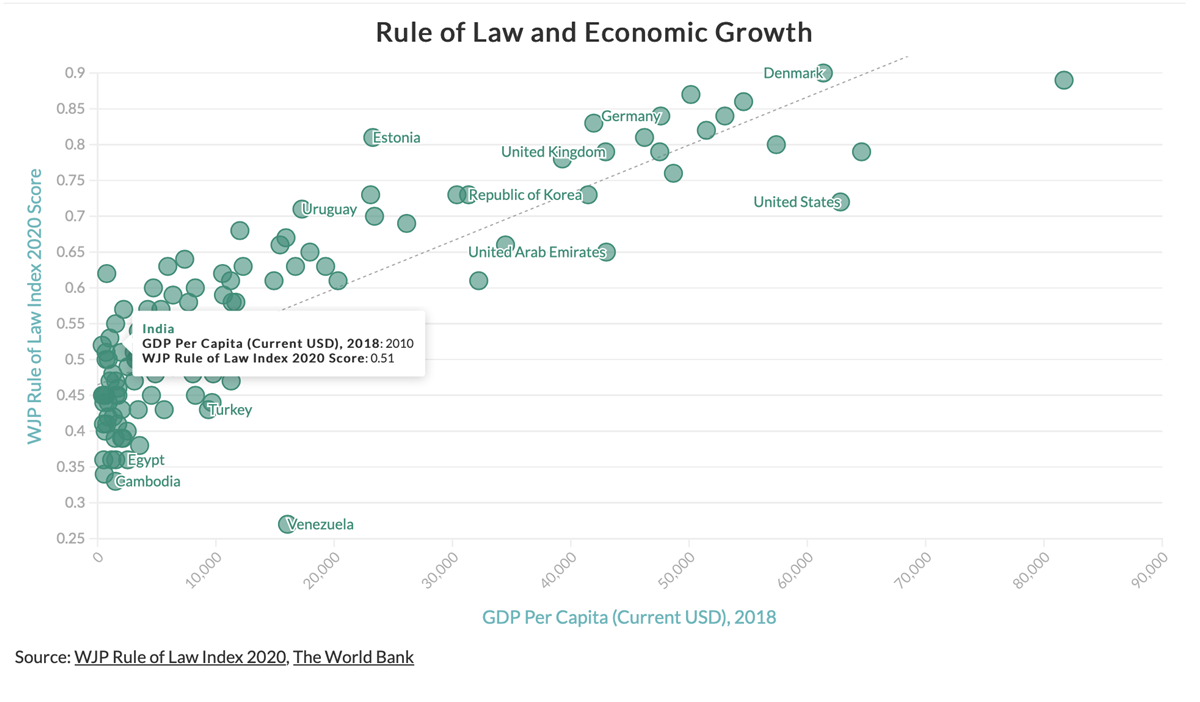
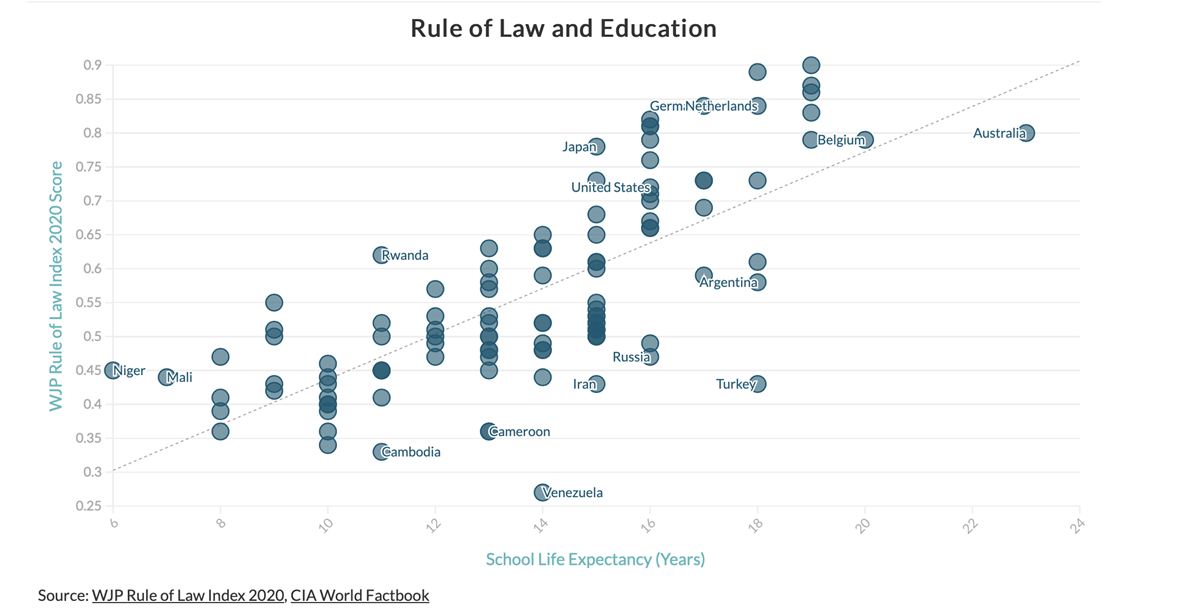
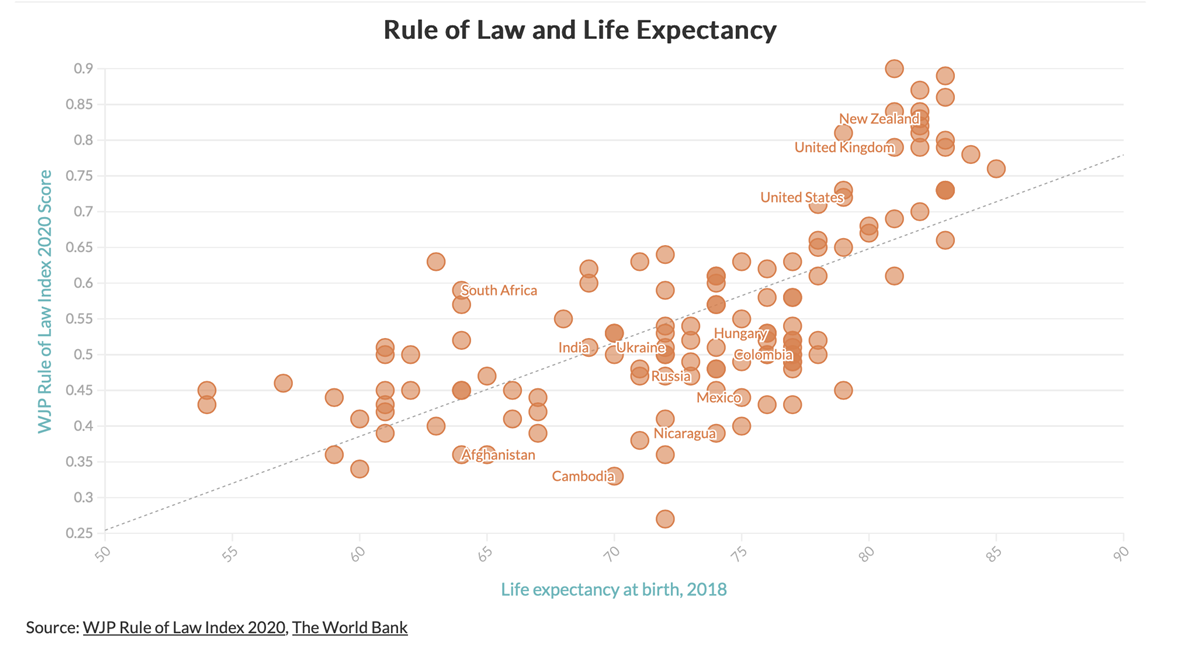
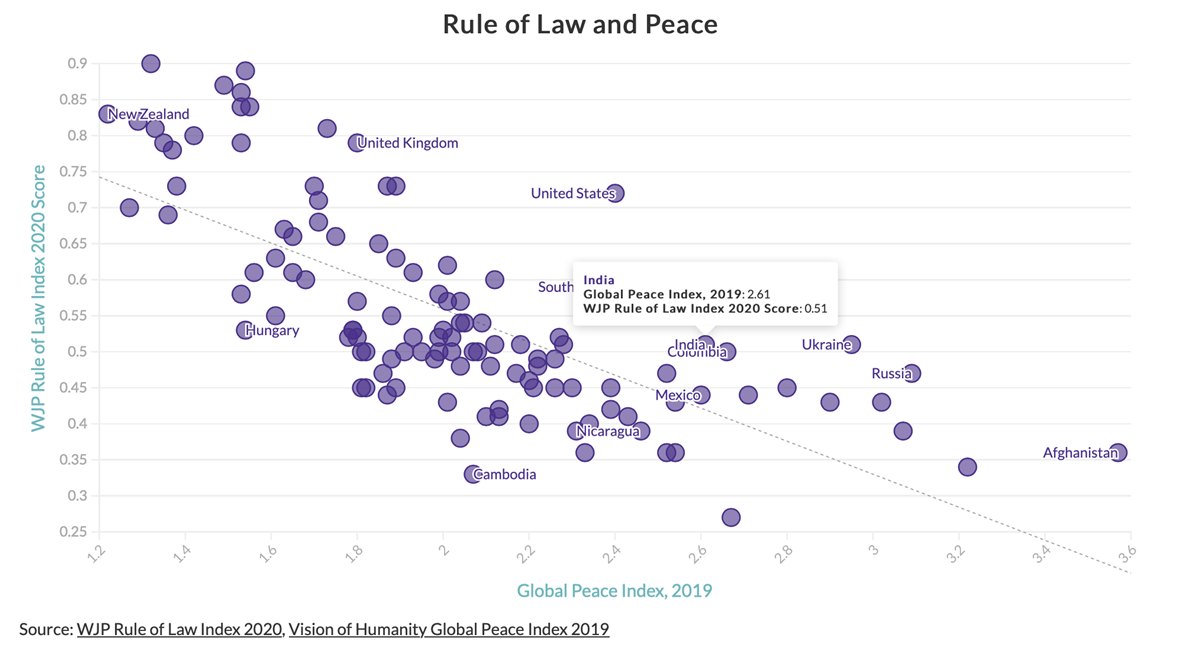
5. India's Stand on the Rule of Law
India’s overall score in the 2022 report is 0.5 and its global rank is 77 out of 140 countries
It is noteworthy that in 6 out of the 8 categories, India’s rank is lower than its overall rank
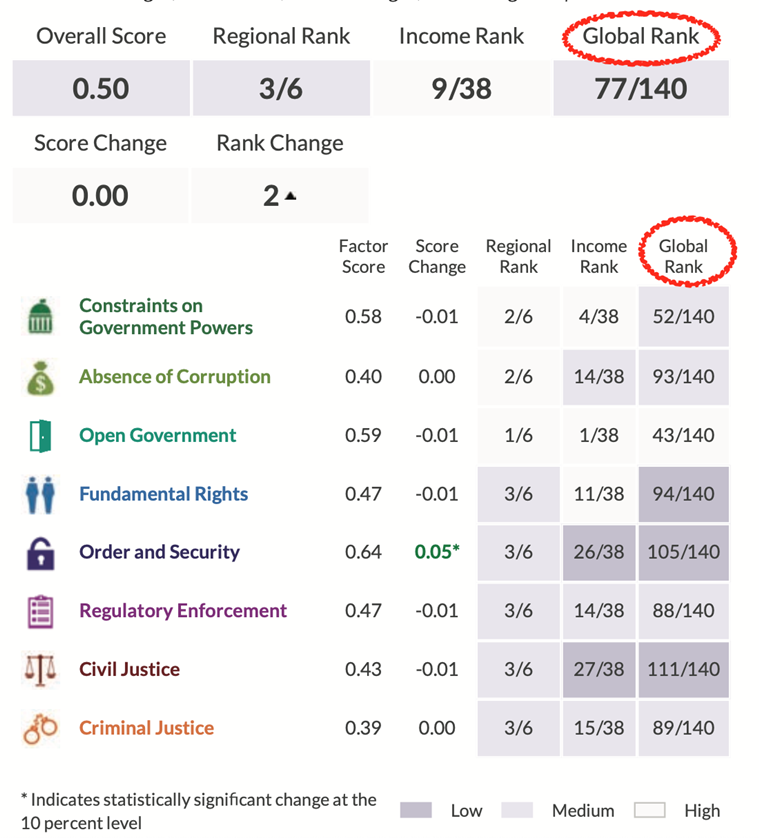
- Even though India’s score hasn’t changed, it has moved up two places in the latest rankings. However, if one compares it to 2015, the score has fallen marginally from 0.51 to 0.50 while the rank has changed from being 59th out of the 102 countries ranked in 2015
- Within the South Asia region, India is placed third, behind Nepal and Sri Lanka, out of six countries; Bangladesh, Pakistan and Afghanistan being the other three
- Among the 38 countries that fall under the same income bracket — namely lower-middle income India is ranked 9th. Countries such as Senegal, Ghana, Indonesia and Ukraine were ahead of India as of the 2022 report
6. Uttar Pradesh's Ranking
The WJP Index does not provide sun-national ranks. However, the India Justice Report (IJR) a collaborative effort between DAKSH, Commonwealth Human Rights Initiative, Common Cause, Centre for Social Justice, Vidhi Centre for Legal Policy and TISS-Prayas for the year 2022 ranks UP at 18 among the 18 large and mid-sized states of India
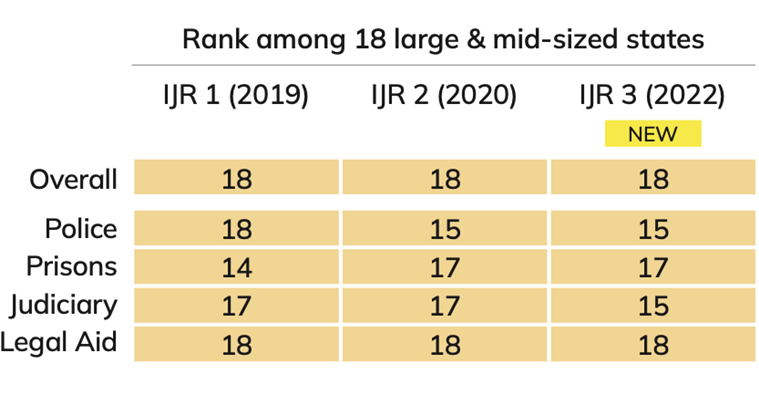
UP was never particularly known for upholding the rule of law. The ongoing approach to dealing with mafia in the state is attracting a lot of attention
Source: indianexpress
CRYPTO LEGISLATION
1. Context
The European Parliament, the legislative body of the 27country block European Union, has approved the world’s first set of comprehensive rules to bring largely unregulated cryptocurrency markets under the ambit of regulation by government authorities. The Markets in Crypto Assets (MiCA) regulation will come into force after formal approval by member states.
2. What are the Markets in Crypto Assets (MiCA) regulations?
- The MiCA law seeks to address concerns like money laundering, protection of consumers and investors, accountability of crypto firms, stablecoins, and the environmental footprint of crypto mining.
- It would regulate the wild west of crypto assets and provide legal certainty for those issuing crypto assets while ensuring high standards for investors and consumers.
- It also excludes non-fungible tokens, but the EU may make horizontal legislation for NFTs in 18 months, after a separate assessment.
3. Why Regulation
- Having a comprehensive framework like MiCA for 27 countries in Europe not only harmonizes the crypto industry but also gives the EU a competitive edge in its growth compared to the U.S. or the U.K. which lack regulatory clarity.
- More importantly, 2022 saw some of the biggest failures and wipeouts in the crypto industry involving bankruptcies and fraud scandals, be it the collapse of the crypto exchange FTX and its spat with Binance or the failure of the Terra LUNA cryptocurrency and its associated stablecoin.
- The liquidity shortage caused by these shocks led other crypto-lending platforms to halt customer transfers and withdrawals before filing for bankruptcy.
4. What kind of Assets will MiCA cover?
- The MiCA legislation will apply to ‘crypto-assets’, which are broadly defined in the text as “a digital representation of a value or a right that uses cryptography for security and is in the form of a coin or a token or any other digital medium which may be transferred and stored electronically, using distributed ledger technology or similar technology”.
- This definition implies that it will apply to traditional cryptocurrencies like Bitcoin and Ethereum and newer ones like stablecoins.
- As for the assets that will be out of MiCA’s scope, will not regulate digital assets that would qualify as transferable securities and functions like shares or their equivalent and other crypto assets that already qualify as financial instruments under existing regulation.
- It will also, for the most part, exclude nonfungible tokens (NFTs).
- MiCA will also not regulate central bank digital currencies issued by the European Central Bank and digital assets issued by national central banks of EU member countries when acting in their capacity as monetary authorities, along with cryptoassetsrelated services offered by them.
5. Importance of New MiCA law?
- The MiCA law aims to address issues like money laundering, investor and consumer protection, crypto company accountability, stablecoins, and the environmental impact of mining for cryptocurrencies.
- It will control the wild world of crypto assets, and give legal clarity to those producing crypto assets, and uphold high standards for consumers and investors.
- Additionally, non-fungible tokens are excluded;
- However, the EU may pass horizontal legislation for NFTs in 18 months following a separate European Commission (EC) evaluation.
6. What are the new rules?
- MiCA will impose compliance on the issuers of crypto assets, who are defined as the “legal person who offers to the public any type of crypto assets”.
- It will apply to crypto asset service providers (CASPs) providing one or more of these services the operation of a trading platform like CoinBase, custody, and administration of cryptoassets on behalf of third parties (customers), the exchange of cryptoassets for funds/other cryptoassets, the execution of orders for cryptoassets, the placing of cryptoassets, providing transfer services for crypto assets to third parties, providing advice on crypto assets and cryptoportfolio management.
- The regulation prescribes different sets of requirements for CASPs depending on the type of crypto assets.
- The base regime will require every CASP to get incorporated as a legal entity in the EU.
- They can get authorized in any one member country and will be allowed to conduct their services across the 27 countries.
- They will then be supervised by regulators like the European Banking Authority and the European Securities and Markets Authority, who will ensure that the companies have the required risk management and corporate governance practices in place.
- Another legislation passed with MiCA requires crypto companies to send information of senders and recipients of crypto assets to their local antimoney laundering authority, to prevent laundering and terror financing activities.
7. Regulation of Crypto in India
- India is yet to have a comprehensive regulatory framework for crypto assets. Draft legislation on the same is reportedly in the works.
- A fullfledged regulation aside, the Indian government has taken certain steps to bring cryptocurrencies under the ambit of specific authorities and taxation.
- In the Union Budget for 2022, the Finance Ministry said that cryptocurrency trading in India has seen a “phenomenal increase” and imposed a 30% tax on income from the “transfer of any virtual digital asset.
- In March this year, the government placed all transactions involving virtual digital assets under the purview of the Prevention of Money Laundering Act (PMLA).
|
For Prelims: The Markets in Crypto Assets (MiCA), Terra LUNA cryptocurrency, crypto-assets, Nonfungible tokens (NFTs), European Commission (EC), Prevention of Money Laundering Act (PMLA), and crypto asset service providers (CASPs).
For Mains: 1.What is cryptocurrency? Discuss the need for the formulation of a clear, constructive, and adaptive regulatory environment for cryptocurrencies in India (250 Words)
|
Previous Year Question
|
1. With reference to “Blockchain Technology”, consider the following statements:
(UPSC CSE 2020)
1. It is a public ledger that everyone can inspect, but which no single user controls.
2. The structure and design of the blockchain are such that all the data in it are about cryptocurrency only.
3. Applications that depend on the basic features of blockchain can be developed without anybody’s permission.
Which of the statements given above is/are correct?
A. 1 only
B. 1 and 2 only
C. 2 only
D. 1 and 3 only
Answer: D
|
Source: The Hindu
INDIA'S MINERAL SUPPLY CHAIN
1. Context
A recent working paper from the Centre for Social and Economic Progress (CSEP) extends the earlier minerals assessment for 23 minerals by assessing the critical levels of 43 select minerals for India based on their economic importance (demand-side factors) and supply risks (supply-side factors) which are determined through the evaluation of specific indicators.
2. Key points
- Critical minerals refer to the mineral resources, both primary and processed, which are essential inputs in the production process of an economy and whose supplies are likely to be disrupted due to the risks of non-availability or unaffordable price spikes.
- To tackle such supply risks, major global economies periodically evaluate which minerals are critical for their jurisdiction through a quantitative assessment.
- Minerals such as antimony, cobalt, gallium, graphite, lithium, nickel, niobium and strontium are among the 22 assessed to be critical for India.
- Many of these are required to meet the manufacturing needs of green technologies, high-tech equipment, aviation and national defence.
- However, while India has a significant mineral geological potential, many minerals are not readily available domestically.
- Hence, India needs to develop a national strategy to ensure resilient critical minerals supply chains, which focuses on minerals found to be critical in this study.
3. The Challenges
- India faces global and domestic challenges in assuring resilient critical minerals supply chains.
- On the international front, there currently exist four significant risks.
- First, China, the most dominant player in the critical mineral supply chains, still struggles with the Covid-19 related lockdowns.
- As a result, the extraction, processing and exports of critical minerals are at risk of slowdown.
- Second, Russia is one of the significant producers of nickel, palladium, titanium sponge metal and the rare earth element scandium.
- Ukraine is one of the major producers of titanium. It also hars reserves of lithium, cobalt, graphite and rare earth elements, including tantalum, niobium and beryllium.
- The war between the two countries has implications for these critical mineral supply chains.
- Third, as the balance of power shifts across continents and countries, the critical mineral supply chains may get affected due to the strategic partnership between China and Russia.
- As a result, developed countries have jointly drawn up partnership strategies, including the Minerals Security Partnership (MSP) and G7's Sustainable Critical Minerals Alliance, while developing countries have missed out.
- Fourth, Manufacturing renewable energy technologies would require increasing quantities of minerals, including copper, manganese, zinc and indium.
- Likewise, the transition to electric vehicles would require increasing amounts of minerals, including copper, lithium, cobalt and rare earth elements.
- However, India does not have many of these mineral reserves and its requirements may be higher than the availability, necessitating reliance on foreign partners to meet domestic needs.
4. The Way Forward
- On the domestic front, India has a geological potential similar to mining-rich.
- In Western Australia, much still needs to be explored.
- India faces four significant challenges to enabling their sustainable extraction.
- First, many critical and strategic minerals constitute part of the list of atomic minerals in the Mines and Minerals (Development and Regulation) (MMDR) Act, 1957.
- However, the present policy regime reserves these minerals only for public sector undertakings.
- Some of these are minerals and ores bearing beryllium, lithium, niobium, titanium, tantalum, zirconium, beach sand minerals and rare earth group minerals containing uranium and thorium.
- Second, given the increasing importance of critical and strategic minerals, there is an imperative need to create a new list of such minerals in the MMDR Act.
- The list may include minerals such as molybdenum, rhenium, tungsten, cadmium, indium, gallium, graphite, vanadium, tellurium, selenium, nickel, cobalt, tin, the platinum group of elements, and fertiliser minerals such as glauconitic, potash, and phosphate (without uranium).
- These minerals must be prospected, explored, and mined on priority, as any delays may hinder India’s emissions reduction and climate change mitigation timeline.
- Third, the reconnaissance and exploration of minerals must be encouraged, with particular attention given to deep-seated minerals.
- This will call for a collective effort by the government, ‘junior’ miners, and major mining companies.
- Fourth, an innovative regime must be devised to allocate critical mineral mining assets, which adequately incentivises private explorers, including ‘junior’ explorers.
- Given the long lead times of setting up new exploration, extraction, and processing activities, these issues must be addressed soon if India is to utilise its natural wealth for its manufacturing needs.
- And Fifth, India needs to determine where and how the processing of minerals and assembly of critical minerals-embedded equipment will occur.
- Currently, India relies on global supplies of various processed critical minerals, as there are limited domestic sources.
- India requires a critical minerals strategy comprising measures aimed at making the country AatmaNirbhar (self-reliant) in critical minerals needed for sustainable economic growth and green technologies for climate action, national defence, and affirmative action for protecting the interests of the affected communities and regions.
- In addition, India must actively engage in bilateral and plurilateral arrangements for building assured and resilient critical mineral supply chains.
- Furthermore, the assessment of critical minerals for India needs to be updated every three years to keep pace with changing domestic and global scenarios.
- A national critical minerals strategy for India, underpinned by the minerals identified in this study, can help focus on priority concerns in supply risks, domestic policy regimes, and sustainability.
|
For Prelims: Centre for Social and Economic Progress, Minerals Security Partnership, MMDR Act, 1957,
For Mains:
1. Discuss the challenges India faces in assuring resilient critical minerals supply chains. (250 Words)
|
|
Previous Year questions
1. With reference to the mineral resources of India, (UPSC 2010)
consider the following pairs:
Mineral 90% Natural sources in
1. Copper Jharkhand
2. Nickel Orissa
3. Tungsten Kerala
Which of the pairs given above is/are correctly matched?
A. 1 and 2 only B. 2 only C. 1 and 3 only D. 1, 2 and 3
Answer: 2
|
Source: The Indian Express
LOCKBIT
1. Context
Recently, for the first, reports emerged that LockBit ransomware was found to be targeting Mac devices. Cybercriminals have developed new ransomware encryptors designed to target macOS devices, making this the first major ransomware operation to specifically target Apple computers. The new encryptors target both older Macs and newer ones running on Apple Silicon. The same gang was also reportedly behind a cyberattack on U.K. postal services earlier this year, causing international shipping to grind to a halt.
2. What is LockBit Ransomware?
- First reported in September 2019 and dubbed the “abcd” virus, due to the file extension used when encrypting victims’ files, the LockBit ransomware is designed to infiltrate victims’ systems and encrypt important files.
- The virus is categorized as a “cryptovirus” due to its requests for payment in cryptocurrency to decrypt files on the victim’s device.
- The ransomware is therefore typically deployed against victims who feel hindered enough by the disruption to pay heavy sums in exchange for access to the files and can afford to do so.
- The gang behind the LockBit ransomware reportedly maintains a dark web portal to recruit members and release data of victims who refuse to meet their demands, as part of their business model.
- In the past, LockBit ransomware has been used to target enterprises and organizations in the U.S., China, India, Ukraine, and Indonesia. Attacks have also been recorded throughout Europe, including France, Germany, and the U.K.
3. Working of Lockbit Ransomware
- It works as a self-spreading malware, not requiring additional instructions once it has successfully infiltrated a single device with access to an organizational intranet.
- It is also known to hide executable encryption files by disguising them in the .png format, thereby avoiding detection by system defenses.
- Attackers use phishing tactics and other social engineering methods to impersonate trusted personnel or authorities to lure victims into sharing credentials.
- Sometimes, the ransomware has also used brute force to gain access to the intranet server and network of an organization.
- Once it has gained access, the ransomware prepares the system to release its encryption payload across as many devices as possible.
- It then disables security programs and other infrastructures that could permit system data recovery.
- The goal is to ensure that data recovery without assistance from the LockBit gang is impossible.
- After this is ensured, the ransomware places an encryption lock on all system files, which can only be unlocked via a custom key created by the LockBit gang.
- The process leaves behind a ransom note, with instructions to restore the system, and has reportedly also included threatening blackmail messages.
- Victims are then left with no choice but to contact the LockBit gang and pay up for the data, which the gang may sell on the dark web whether the ransom is paid or not.
4. Why is LockBit targeting macOS?
- Historically, ransomware has targeted Windows, Linux, and VMware ESXi servers. However, LockBit is now working to create encryptors targeting Macs for the first time, a report from Bleeping Computer said.
- Analysis of the encryptors revealed they were put together as a test, rather than an actual readytouse ransomware.
- Experts believe that, after launching multiple attacks across Europe and Asia, the gang is developing tools to target macOS and further increase the scope of attacks to bring in more financial gains for the operation.
5. What actions authorities have taken?
- Due to its ransomwareasaservice model, the LockBit gang has been on the authorities’ radar for some time now.
- In November 2022, a dual Russian and Canadian national with suspected links to the gang was arrested, in Ontario, Canada for his alleged involvement in attacks targeting critical infrastructure and large organizations.
- The arrest came after similar action was taken in Ukraine, in October 2021, a report from TechCrunch said.
- A press release from the U.S. Department of Justice notes that LockBit has claimed at least 1,000 victims in the U.S., extracting millions of dollars in the process.
6. Measures to protect systems against the LockBit ransomware
- While there are no foolproof ways of protecting against ransomware attacks, organizations and individuals can take certain steps to increase resilience against such cyber threats.
- The use of strong passwords, with strong variations of special characters which are not easy to guess along with multifactor authentication should be implemented.
- This ensures the use of brute force will not be enough to compromise systems.
- Organizations can also undertake training exercises to educate employees on the use of phishing attacks and their identification.
- Old and unused user accounts should be deactivated and closed as they can become weak links in the security apparatus.
- Additionally, organizations and individuals should have an understanding of cybersecurity threats and vulnerable points that may be exploited by cybercriminals.
|
For Prelims: LockBit ransomware, macOS, LockBit gang, Windows, Linux, and VMware ESXi servers, and Cybersecurity.
For Mains: 1. What is LockBit Ransomware? Discuss the Working of Lockbit Ransomware and Measures to protec
|




